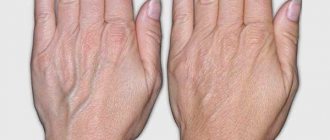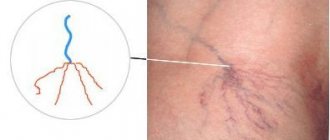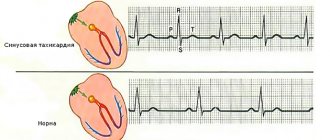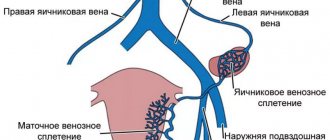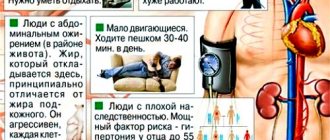Varicose veins are one of the most common vascular pathologies. This chronic, constantly progressive disease most often affects the lower extremities, but the vessels of other organs, in particular the colon, esophagus, uterus, ovaries, and labia, can be affected by pathological changes.
The early stages of pathology are often perceived by patients as a cosmetic defect; as the disease progresses, the patient’s well-being and general condition worsen.
Let's figure out what it is - varicose veins of the uterus, vessels of the labia and other organs of this area, how the disease manifests itself
General information about the disease
Varicose changes in the vessels of the genital organs (genital varicose veins) most often occur during pregnancy in approximately 40% of expectant mothers and can spontaneously disappear after childbirth .
Pathological changes in blood vessels in nulliparous women are much less common and spider veins form on the labia, then varicose nodes appear, both labia or one of them enlarge. Enlarged veins are painful and very vulnerable. Sexual intercourse, labor or significant physical activity sometimes provoke ruptures of the affected vessels , which are accompanied by severe bleeding.
Any changes in the size of the external genitalia are a reason to consult a doctor to prevent possible complications.
Do varicose veins on the vulva go away or not?
Symptoms of vulvar varicose veins may worsen with each subsequent pregnancy.
In most cases, varicose veins of the vulva do not remain for long. Typically, symptoms disappear soon after delivery.
However, women who experience varicose veins during one pregnancy may experience them again during the second. With each subsequent pregnancy, the condition of the veins may worsen and the pain may intensify.
When varicose veins do not go away on their own, a woman should talk to her doctor, who can identify underlying medical conditions such as poor circulation.
Doctors can remove the veins fairly easily through surgical procedures. However, in women with a history of varicose veins, enlarged veins often continue to appear in other places, so it is best to give them time to disappear on their own.
Causes of varicose veins in the groin
In addition to pregnancy, other factors can provoke varicose changes in the genitals. hereditary predisposition one of the key reasons for pathological changes in veins . Vessels with weakened walls, congenital or acquired valve insufficiency, and the disease can develop against the background of decreased venous tone are susceptible to varicose expansion.
The situation is aggravated by obesity, strong and sudden physical activity , as well as features of professional activity. Pathologies of venous circulation most often occur in people who, due to their occupation, have to spend a lot of time standing or sitting.
In some cases, the disease occurs against the background of endocrine changes in the body , including those caused by taking hormonal drugs. An additional risk factor is inflammatory processes in the pelvic organs.
Varicose veins of the uterus can occur for the same reasons. However, additional prerequisites for the onset of a pathological process in the uterus may be:
- Abortion;
- Insufficiency of the valves of the ovarian veins;
- Menstrual irregularities.
The risk of developing genital varicose veins increases significantly if you have symptoms of varicose veins in the legs.
Why do varicose veins of the labia develop?
During pregnancy, women experience aggravation of all chronic diseases as the body weakens. This is because the immune system in a normal (unsuppressed) state will push the fetus out of the body.
Varicose veins of the labia during pregnancy develop for the following reasons:
- A woman’s body weight increases, and this puts stress on the veins. The subcutaneous vessels are not surrounded by muscles, unlike the deep veins. Therefore, they suffer due to the load in the first place;
- The volume of circulating blood increases, which negatively affects the veins. The walls of veins are less elastic than the walls of arteries;
- As the fetus develops, the uterus grows in women, it delays the outflow of blood in the veins of the pelvic organs;
- The body produces progesterone, and already in the first stages of pregnancy the amount of the hormone increases. Excess progesterone affects the condition of collagen fibers.
Varicose veins of the labia are affected by hereditary predisposition, poor nutrition, and work habits (during a long stay in a standing position).
A few photos:
Diagnostics
When the first signs appear, you need to go to an appointment with a gynecologist. He will conduct an examination, examine the vagina and mucous membranes using a special mirror.
To confirm the analysis, the doctor prescribes an ultrasound of the pelvic organs, which will assess the condition of the venous system. If necessary, an examination by a phlebologist is necessary. Also, expectant mothers will have to undergo a general blood test to determine the prothrombin index and do a Doppler ultrasound.
Stages of development
The course of the disease is usually divided into three stages; some doctors tend to distinguish the so-called preclinical or initial stage. The preclinical stage refers to the period of latent course of the disease , when the pathological process is already underway, but external changes are almost imperceptible.
The first stage is the appearance of spider veins and venous nodules on the mucous membrane of the affected organ.
Second stage . Venous nodes enlarge and form “clusters”. The affected labia becomes swollen and increases in size. Characteristic itching and burning appear, the skin and mucous membrane become dark in color. Patients report feelings of heaviness, fullness, and possible dysuric disorders.
The third stage is characterized by soreness of the affected vessels, the walls of the dilated vessels become thinner, and there is a high risk of ruptures and severe bleeding.
Possible complications
With a progressive pathological process, the threat of damage to the affected vessels increases during sexual intercourse or other stress that causes a rush of blood to the pelvic organs.
With varicose veins, regardless of the location of the lesion, the risk of vein thrombosis increases with the further development of thrombophlebitis. A thrombosed vein is painful on palpation; the inflammatory process is indicated by an increase in temperature to 38-39 degrees.
The presence of blood clots poses a danger to life, since blood clots can break off from the walls of blood vessels and be carried by the blood stream throughout the body, leading to embolism (blockage) of blood vessels of vital organs . The greatest threat is posed by conditions caused by blood clots entering the vessels of the lungs and heart.
Varicose veins of the uterus can lead to thrombophlebitis and thrombosis of the ovarian veins, and also indirectly affects the hormonal levels of a woman’s body. Obstructed venous circulation in this area leads to a decrease in the concentration of sex hormones and entails menstrual irregularities.
In the absence of adequate timely treatment, the development of functional infertility cannot be ruled out. Uterine varicose veins are particularly dangerous during pregnancy and childbirth and are one of the indications for surgical delivery.
Causes
The causes of varicose veins of the genital organs during pregnancy are multifaceted. The position itself is a powerful predisposing factor.
Don't wear high heels
Women awaiting replenishment experience severe stress on the body, which leads to an exacerbation of existing chronic diseases. The development of pathology becomes a manifestation of general varicose veins or the first signal of a disruption in the functioning of the veins.
- increase in circulating blood volume. Increases pressure on blood vessels. Since the walls of veins have less density and elasticity compared to arteries, they suffer first;
- pressure of the growing uterus on the pelvic organs. Leads to a delay in the outflow of blood from the lower extremities;
- weight gain. Increases the load on blood vessels. The saphenous veins, which are not surrounded by muscles, are especially affected;
- increase in progesterone levels. Its excess impairs the elasticity of blood vessels and promotes venous stagnation.
This is especially true for women who used hormonal medications before pregnancy or suffered from hormonal disorders.
Not the least role in the development of the disease is played by the hereditary factor, diet, lifestyle, and work characteristics. For example, excess body weight, standing or sedentary occupation predisposes to the manifestation of pathology during pregnancy.
Symptoms
A characteristic symptom of varicose veins of the labia is the formation of spider veins, strands or nodules on the mucous membrane . The labia increases in size. As the disease progresses, sensations of fullness or heaviness, itching, soreness, and urination problems appear.
Varicose veins of the uterus are manifested by pain and unpleasant pulling sensations in the lower abdomen , which intensify under stress, during physical activity and menstruation. Pain may occur in the lumbar region.
In the early stages of the disease, pain is episodic, but as the pathology progresses, it becomes constant . Against the background of varicose veins of the uterus, the symptoms of premenstrual syndrome intensify.
Congestion in the pelvis leads to disruptions in the menstrual cycle; the interval between menstruation can reach 60 days . The absence of characteristic symptoms of the disease makes diagnosis very difficult.
Diagnostics
Symptoms of varicose veins of the genital organs resemble the clinical picture of a number of gynecological diseases of various etiologies: endometriosis, cysts and inflammatory processes.
The primary diagnosis is carried out by a gynecologist . During the examination, it is possible to detect characteristically altered vessels; during a vaginal examination, cyanosis of the mucous membranes and severe swelling are revealed. If genital varicose veins are suspected, the patient is recommended to donate blood for a coagulogram.
An intravaginal ultrasound examination is required , which allows you to determine the condition of the uterine veins.
In controversial cases, Doppler sonography, duplex scanning or radiopaque venography may additionally be performed. Instrumental diagnostic methods make it possible to identify the exact location of the lesion and assess the condition of the vessel and valves.
Treatment
Treatment methods used in the treatment of varicose veins of the genital organs are the same for all forms of this type of vascular pathology. They are divided into the following groups :
- Conservative;
- Surgical;
- Combined;
- Sclerotherapy.
Let us consider in detail how to treat varicose veins on the uterus or labia using different methods.
Conservative
The course of conservative treatment of varicose veins of the genital organs must include venotonic drugs in the form of ointments, gels, and in the case of damage to the internal veins - in the form of tablets. The most effective are medicines containing heparin and ginkgo biloba extract. Patients are prescribed Phlebodia, Troxerutin, Diosmin, Hesperidin, Lyoton .
Patients with different forms of genital varicose veins are recommended to wear compression garments (which is better for varicose veins?) and a set of exercises aimed at normalizing venous blood flow in the lower part of the body.
It is advisable to exclude tight clothes from your wardrobe , especially models with tight elastic bands . It is also necessary to consciously control your weight and radically review your diet, eliminating obviously harmful foods from it.
Surgical
Surgical treatment methods are used in cases where conservative therapy is obviously ineffective . This can be either resection of pathologically altered veins or laser coagulation. In advanced cases of varicose veins of the uterus, a hysterectomy is performed. Surgery is often combined with conservative treatment.
Sclerotherapy
The most progressive method of treating varicose veins is sclerotherapy. The essence of the method is the introduction of a sclerosant drug into the affected vessels . The sclerosant “glues” the damaged vessel and the blood flow is redirected to bypass the problem area. The procedure is performed on an outpatient basis and immediately after the procedure the patient should wear compression garments.
Several types of sclerotherapy are used in practice; foam and echosclerotherapy have recently become especially popular.
Symptoms
In women suffering from varicose veins of the labia, the external genitalia swell, the veins swell and often form entire conglomerates of nodes. Strains and spider veins appear on the mucous membrane and skin. Irritated and dry skin of the perineum itches, goes numb or hurts, there is a feeling of burning, bloating and discomfort, and dysuric disorders appear. These unpleasant and painful sensations intensify during sexual intercourse, after physical activity and visiting the toilet. Aching pain usually radiates to the sacrum and perineum. The woman’s psychological state worsens, her mood decreases, and increased irritability appears.
Specialists visually detect deformation of the veins, which are an aesthetically unpleasant sight. First, a small nodule appears on the labia, which does not manifest itself clinically. Gradually, there are many nodules, they increase in size and interfere with normal sitting, walking, and sexual activity. Venous nodules, cords and lumps grow and can be felt during palpation. The affected dry skin of the perineum becomes pigmented. In the last stages of pregnancy, the pain becomes excruciating, and obvious signs of varicose veins are most noticeable. In severe cases, patients walk and sit with great difficulty.
If clinical signs of the disease appear, you should immediately consult a doctor to conduct additional studies and prescribe appropriate treatment.
Complications of varicose veins of the labia are: bleeding and rupture of the perineum during childbirth, as well as varicothrombophlebitis, blood thickening, pelvic vein thrombosis.
You can detect varicose veins in the perineum yourself by feeling the external genitalia. Diagnosis and treatment of varicose veins of the labia are carried out by gynecologists, phlebologists and vascular surgeons. The doctor examines the woman, listens to complaints and collects anamnesis. Additional diagnostic methods include: clinical blood test, coagulogram, ultrasound. Ultrasound examination allows you to see the condition of the venous wall and confirm the diagnosis of the disease.
Read also: Press method for treating varicose veins with foil
Treatment of pregnant women is a difficult and very responsible process. Pregnant women can completely get rid of varicose veins only after childbirth. Effective and correct therapy will help reduce the severity of the clinical symptoms of the disease and stop the further development of the pathological process. Suitable and safe medications prescribed by a doctor will significantly improve the condition of the veins, making them less noticeable and painful.
For pregnant women suffering from varicose veins of the labia, experts give the following recommendations:
- Do not lift objects that weigh more than 3 kg,
- Provide optimal (moderate) physical activity,
- Control your weight
- Regulate bowel function
- Visit the pool
- Do not take hot baths, use showers,
- Wear comfortable underwear
- Maintain personal hygiene rules,
- Rest in a special position: lying on your left side with your knees bent and pressed to your stomach.
Conservative treatment consists of wearing compression garments, using anesthetic creams and using medications. It is aimed at stopping the reverse flow of blood and relieving pain symptoms.
- Patients are prescribed venotonics in the form of tablets, gels and ointments - “Troxerutin”, “Detralex”, “Lioton”, “Venoruton”, “Eskuzan”.
- Antiplatelet agents that prevent thrombus formation - Trental, Curantil, Venolife, Aspirin.
- Wearing compression underwear helps reduce congestion, accelerates blood circulation, eliminates the manifestations of pathology and improves the well-being of a pregnant woman.
- Vitamin therapy - taking vitamin C, which thins the blood and improves blood circulation, as well as vitamin E, which improves the elasticity of blood vessels.
- Therapeutic exercises will help reduce pain. To do this, you need to get on all fours and lower your head onto the pillow so that your pelvis is higher than your head. This position promotes blood flow.
- If the cause of varicose veins of the labia is not pregnancy, symptomatic therapy is carried out. Patients are prescribed antiplatelet agents, anti-inflammatory and painkillers.
- Sclerotherapy is a medicinal way to get rid of varicose veins of the labia. This is an injection technique that allows the changed veins to completely disappear. The area affected by varicose veins is cooled with air, and then a special solution is injected into the vein, which narrows it and pushes blood through, stopping blood flow and preventing blood clots. The affected vessel stops functioning, and the blood flows through healthy veins. After the injection, apply bilateral compression to the affected area for 5 - 7 minutes.
Sclerotherapy is the most effective and generally painless method of treating genital varicose veins, carried out on an outpatient basis and bringing high-quality results. Labiaplasty and microthermocoagulation are also possible. But these methods are strictly contraindicated for pregnant women.
If varicose veins of the labia do not go away after the baby is born, but continues to progress, proceed to surgical intervention. The main types of operations for varicose veins are classic phlebectomy, radiofrequency and laser coagulation of deformed veins.
Prognosis and prevention
With timely detection and appropriate treatment, genital varicose veins do not pose a threat to life . However, it should be taken into account that the disease is prone to relapse and cannot yet be completely cured.
To maintain a stable condition of the blood vessels, patients are advised to adhere to the same recommendations as for the conservative treatment of varicose veins:
- Lead a healthy lifestyle, observing work and rest schedules;
- Avoid significant physical activity;
- Stop taking oral contraceptives or change the drug after consulting a gynecologist;
- Maintain weight within normal limits;
- Follow a gentle diet, avoiding too salty, spicy, fatty foods, foods that cause constipation;
- Stop smoking and drinking alcohol;
- Eliminate uncomfortable high-heeled shoes and too-tight clothes from your wardrobe.
In order to prevent vascular pathologies, it is desirable to optimize physical activity. An ideal sport for people prone to varicose veins is swimming and water aerobics . In some cases, the doctor may additionally recommend regular wearing of compression stockings, as well as taking medications that thin the blood and strengthen the walls of blood vessels.
Varicose veins of the genital organs are not a harmless cosmetic defect. It must be treated promptly to avoid more serious problems in the future.
Methods of delivery
Pregnant women ask their personal gynecologist how varicose veins of the perineum and childbirth are combined. He can answer this question only after a complete examination and determination of the severity of the disease. In some cases, the disease is not a direct contraindication for independent childbirth. After the birth of a child, there is a possibility that the symptoms of varicose veins will subside and be completely cured.
In advanced and severe cases, the pathology threatens the opening of severe bleeding during pushing due to rupture of damaged vessels. Natural childbirth with varicose veins can lead to a serious complication in the form of acute varicothrombophlebitis. The inflammatory disease affects the veins located on the surface of the epidermis.
Blood clots form in them, causing redness and hardening of a large area around the localization. If there is such a danger, a decision may be made to perform a caesarean section. It will allow you to avoid possible difficulties during delivery and prevent the development of complications.
Expectant mothers, faced with symptoms of inguinal varicose veins, should not be nervous and try to get rid of the pathology with folk remedies. The best solution would be an unscheduled visit to the gynecologist and diagnostic tests. Based on their results, it will already be clear whether it is possible to cure the pathology before childbirth or whether you will have to agree to a caesarean section.
